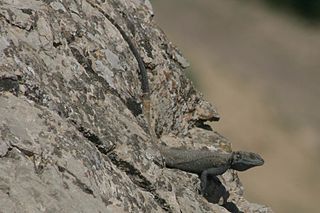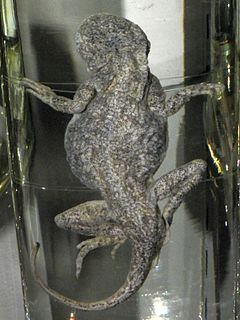
Agama is a genus of small-to-moderate-sized, long-tailed, insectivorous Old World lizards. The genus Agama includes at least 37 species in Africa, especially sub-Saharan Africa, where most regions are home to at least one species. Eurasian agamids are largely assigned to genus Laudakia. The various species differ in size, ranging from about 12 to 30 centimetres in length, when fully grown.

Calotes is a genus of lizards in the draconine clade of the family Agamidae. The genus contains 29 species. Some species are known as forest lizards, others as "bloodsuckers" due to their red heads, and yet others as garden lizards.

Ceratophora is a genus of agamid lizards found in Sri Lanka. The male has a horn on its snout.

Draco is a genus of agamid lizards that are also known as flying lizards, flying dragons or gliding lizards. These lizards are capable of gliding flight via membranes that may be extended to create wings (patagia), formed by an enlarged set of ribs. They are arboreal insectivores.

Laudakia is a genus of lizards, commonly known as Asian rock agamas, in the family Agamidae. The genus is endemic to Asia.

The Mexican Plateau horned lizard is a species of horned lizard. It is also known as the Chihuahua Desert horned lizard. The specific epithet, orbiculare, comes from the Latin adjective orbis, meaning "circular".

Japalura tricarinata is a species of agamid lizard endemic to Asia.
Laudakia agrorensis, the Agror agama, is a species of agamid lizard. It is found in eastern Afghanistan, northwestern India, and northern Pakistan.

The Caucasian agama is a species of agamid lizard found in the Caucasus, E/S Georgia, Armenia, Azerbaijan, Turkmenistan, Tajikistan, Dagestan (Russia), E Turkey, Iraq, N Iran, Afghanistan, NW Pakistan, and parts of Kashmir.
Laudakia dayana, commonly known as the Haridwar agama, is a species of agamid lizard. It is endemic to northwestern India.
Laudakia melanura, also known as the black agama, is a species of agamid lizard. It is found in Iran, Afghanistan, Pakistan, and northern India.

The common agama, red-headed rock agama, or rainbow agama is a species of lizard from the family Agamidae found in most of sub-Saharan Africa. To clear up historical confusion based on Linnaeus and other authors, Wagner, et al. (2009) designated a neotype for the species, using a previously described specimen from Cameroon in the collection of the Zoologisches Forschungsmuseum Alexander Koenig in Bonn. The species name was formerly applied to a paraphyletic collection of taxa, and mitochondrial DNA analysis of various populations indicates they represent separate species., Consequently, three former subspecies A. a. africana, A. a. boensis, and A. a. mucosoensis are now considered separate species, and A. a. savattieri is considered synonymous with A. africana.

Dolichophis jugularis, the black whipsnake, is a species of snake in the family Colubridae.

Paralaudakia stoliczkana is a species of lizard in the family Agamidae. The species is native to Xinjiang and Gansu provinces in China, the western parts of Mongolia, and to Kyrgyzstan. There are two recognized subspecies.

Laudakia nupta is a species of lizard from Iraq, Iran, Afghanistan, and Pakistan. It was described in 1843. There are two subspecies, Laudakia nupta nupta and Laudakia nupta fusca.

Laudakia sacra, also known commonly as Anan's rock agama, is a species of lizard in the family Agamidae. The species is endemic to Tibet.
Wilms's agama, shield-tail agama or turnip-tail agama, is a species of lizard in the family Agamidae. The species is endemic to the Horn of Africa.

Phrynocephalus guttatus, also known commonly as the spotted toadhead agama, the Saissan toad-headed agama, the Central Asian toadhead agama, and Salensky's toadhead agama, is a species of lizard in the family Agamidae. The species is native to southeastern Europe and western Asia. There are five recognized subspecies.


















